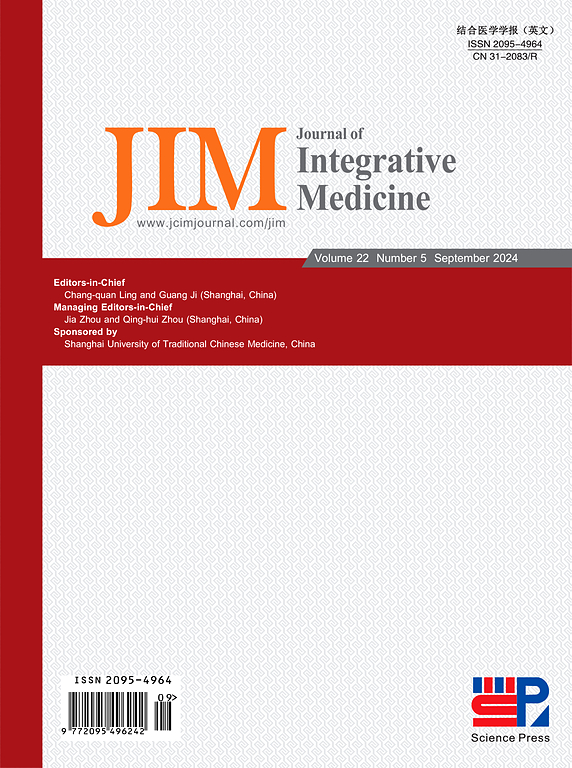Thoughts on the construction of flagship hospitals of integrated traditional Chinese and Western medicine in China
IF 4
2区 医学
Q1 INTEGRATIVE & COMPLEMENTARY MEDICINE
引用次数: 0
Abstract
Traditional Chinese medicine (TCM) is a treasure of the Chinese culture, with a long history of use, while Western medicine, characterized by empirical evidence and linear methods, is an established global medical system. The integration of these two systems provides a synergistic strategy capable of tackling medical issues inadequately treated by each system independently. The history of integrated Chinese and Western medicine in China dates back to the 19th century and has evolved significantly, particularly with support from the Chinese government in recent decades. This commentary outlines the necessary conditions for successful integration of the two systems, including mutual respect, collaboration, and innovation within TCM, while also accessing modern information technologies such as artificial intelligence and high-throughput-omics techniques. Meanwhile, flexible hospital management systems and guidelines for evaluating quality of service are needed to support integrative work and need attention. The ultimate goal of constructing top-tier public medical institutions in China that integrate TCM and Western medicine will lead to more capable and accessible clinical services and improved healthcare outcomes.
Please cite this article as: Yan SY. Thoughts on the construction of flagship hospitals of integrated traditional Chinese and Western medicine in China. J Integr Med. 2025; 23(1): 12–14.
中国中西医结合旗舰医院建设的思考。
中医是中华文化的瑰宝,有着悠久的使用历史,而西医以经验证据和线性方法为特点,是一个成熟的全球医学体系。这两个系统的整合提供了一种协同战略,能够解决每个系统独立治疗不足的医疗问题。中国中西医结合的历史可以追溯到19世纪,并在近几十年中国政府的支持下取得了重大进展。这篇评论概述了成功整合两个系统的必要条件,包括中医内部的相互尊重、合作和创新,同时也利用现代信息技术,如人工智能和高通量组学技术。同时,需要灵活的医院管理制度和服务质量评价指南来支持一体化工作,需要引起重视。最终目标是在中国建设一流的中西医结合的公立医疗机构,这将带来更有能力和更容易获得的临床服务,并改善医疗保健结果。请引用这篇文章:Yan SY。中国中西医结合旗舰医院建设的思考。集成医学[J];打印前Epub。
本文章由计算机程序翻译,如有差异,请以英文原文为准。
求助全文
约1分钟内获得全文
求助全文
来源期刊

Journal of Integrative Medicine-Jim
Medicine-Complementary and Alternative Medicine
CiteScore
9.20
自引率
4.20%
发文量
3319
期刊介绍:
The predecessor of JIM is the Journal of Chinese Integrative Medicine (Zhong Xi Yi Jie He Xue Bao). With this new, English-language publication, we are committed to make JIM an international platform for publishing high-quality papers on complementary and alternative medicine (CAM) and an open forum in which the different professions and international scholarly communities can exchange views, share research and their clinical experience, discuss CAM education, and confer about issues and problems in our various disciplines and in CAM as a whole in order to promote integrative medicine.
JIM is indexed/abstracted in: MEDLINE/PubMed, ScienceDirect, Emerging Sources Citation Index (ESCI), Scopus, Embase, Chemical Abstracts (CA), CAB Abstracts, EBSCO, WPRIM, JST China, Chinese Science Citation Database (CSCD), and China National Knowledge Infrastructure (CNKI).
JIM Editorial Office uses ThomsonReuters ScholarOne Manuscripts as submitting and review system (submission link: http://mc03.manuscriptcentral.com/jcim-en).
JIM is published bimonthly. Manuscripts submitted to JIM should be written in English. Article types include but are not limited to randomized controlled and pragmatic trials, translational and patient-centered effectiveness outcome studies, case series and reports, clinical trial protocols, preclinical and basic science studies, systematic reviews and meta-analyses, papers on methodology and CAM history or education, conference proceedings, editorials, commentaries, short communications, book reviews, and letters to the editor.
Our purpose is to publish a prestigious international journal for studies in integrative medicine. To achieve this aim, we seek to publish high-quality papers on any aspects of integrative medicine, such as acupuncture and traditional Chinese medicine, Ayurveda medicine, herbal medicine, homeopathy, nutrition, chiropractic, mind-body medicine, taichi, qigong, meditation, and any other modalities of CAM; our commitment to international scope ensures that research and progress from all regions of the world are widely covered. These ensure that articles published in JIM have the maximum exposure to the international scholarly community.
JIM can help its authors let their papers reach the widest possible range of readers, and let all those who share an interest in their research field be concerned with their study.
 求助内容:
求助内容: 应助结果提醒方式:
应助结果提醒方式:


